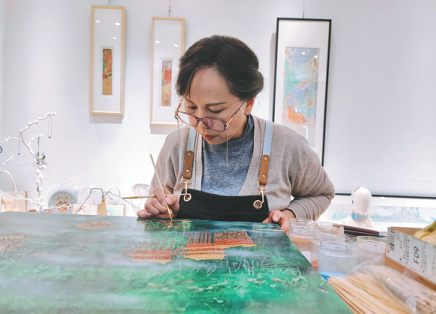Polishing centuries of lacquer art tradition
Updated: 2023-05-05

Guo Ximei works on a piece of lacquerwork at her studio in Taiyuan. [Photo by Zhao Lina for China Daily]
Chinese lacquer art, with a history of more than 8,000 years, is still evolving and flourishing thanks to the efforts of creative practitioners like Guo Ximei.
Guo, a resident of Taiyuan, the capital city of North China's Shanxi province, said her approach to the millennia-old craft is innovative inheritance. She continues to use natural lacquer despite a wide variety of synthesized alternatives.
Natural lacquer, which is extracted from lacquer trees, is mainly composed of urushiol, lactase, gum and liquid.
It is utilized as a coating for wood products due to its resistance to corrosion, moisture and high temperature. Traditional lacquer art involves paintings and engravings on the lacquered surface.
"Craftsmanship is still the basic requirement and major source of inspiration for a successful lacquer artist in modern times," Guo said, adding that lacquer ware production is a comprehensive art requiring highly refined skills in pattern design, selection of materials, body construction, painting, enameling, engraving and polishing.
While adhering to traditional techniques and values in creating the art, there is ample room for innovation in today's market, Guo said.
She added that enriched application procedure is a primary example.
"In the past, lacquer art was mostly used for furniture decoration," Guo said. But today, in her Taiyuan studio, lacquer ware creations cover a wide variety of items, including cups, earrings, bracelets, handbags and even postcards.
"Lacquer art needs to adapt to contemporary life and modern aesthetics by incorporating modern functionality and cultural elements," said Guo, who creates her art on silk, cotton, linen and paper, in addition to the traditional application on wood.
While patterns of traditional lacquer ware focus on flowers, animals, birds and human figures, Guo has enriched her artistic expressions by including such topics as natural landscapes and historical events.
Shanxi topography, including the Great Wall, the Yellow River and the Taihang Mountains are among the subjects depicted in Guo's creations.
"I hope my art can play a role in promoting Shanxi's tourism attractions," she said.
"My studio hosts regular workshops for local students and we also offer online teaching programs for them. I hope to enhance people's awareness and enthusiasm by helping preserve the traditions of this art."
Zhao Lina and Zhang Caiyun contributed to this story.



